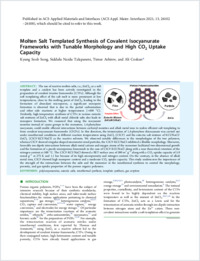Molten Salt Templated Synthesis of Covalent Isocyanurate Frameworks with Tunable Morphology and High CO2 Uptake Capacity
DOKPE
- Song, Kyung Seob University of Fribourg
- Talapaneni, Siddulu Naidu ORCID University of New South Wales (UNSW)
- Ashirov, Timur University of Fribourg
- Coskun, Ali ORCID University of Fribourg
- 2021
Published in:
- ACS Applied Materials and Interfaces. - American Chemical Society (ACS). - 2021, vol. 13, no. 22, p. 26102-26108
General Materials Science
polyisocyanurates
eutectic salts
ionothermal synthesis
template synthesis
gas sorption
English
The use of reactive molten salts, i.e., ZnCl2, as a soft template and a catalyst has been actively investigated in the preparation of covalent triazine frameworks (CTFs). Although the soft templating effect of the salt melt is more prominent at low temperatures, close to the melting point of ZnCl2, leading to the formation of abundant micropores, a significant mesopore formation is observed that is due to the partial carbonization and other side reactions at higher temperatures (>400 °C). Evidently, high-temperature synthesis of CTFs in various eutectic salt mixtures of ZnCl2 with alkali metal chloride salts also leads to mesopore formation. We reasoned that using the isocyanate moieties instead of cyano groups in the monomer, 1,4-phenylene isocyanate, could enable efficient interactions between carbonyl moieties and alkali metal ions to realize efficient salt templating to
form covalent isocyanurate frameworks (CICFs). In this direction, the trimerization of 1,4-phenylene diisocyanate was carried out under ionothermal conditions at different reaction temperatures using ZnCl2 (CICF) and the eutectic salt mixture of KCl/NaCl/ ZnCl2 (CICF-KCl/NaCl) as the reactive solvents. We observed notable differences in the morphologies of the two polymers, whereas CICF showed irregular-shaped micrometer-sized particles, the CICF-KCl/NaCl exhibited a filmlike morphology. Moreover, favorable ion-dipole interactions between alkali metal cations and oxygen atoms of the monomer facilitated two-dimensional growth and the formation of a purely microporous framework in the case of CICF-KCl/NaCl along with a near theoretical retention of the nitrogen content at 500 °C. The CICF-KCl/NaCl showed a BET surface area of 590 m2 g−1 along with a CO2 uptake capacity of 5.9 mmol g−1 at 273 K and 1.1 bar because of its high microporosity and nitrogen content. On the contrary, in the absence of alkali metal ions, CICF showed high mesopore content and a moderate CO2 uptake capacity. This study underscores the importance ofthe strength of the interactions between the salts and the monomer in the ionothermal synthesis to control the morphology, porosity, and gas uptake properties of the porous organic polymers.
form covalent isocyanurate frameworks (CICFs). In this direction, the trimerization of 1,4-phenylene diisocyanate was carried out under ionothermal conditions at different reaction temperatures using ZnCl2 (CICF) and the eutectic salt mixture of KCl/NaCl/ ZnCl2 (CICF-KCl/NaCl) as the reactive solvents. We observed notable differences in the morphologies of the two polymers, whereas CICF showed irregular-shaped micrometer-sized particles, the CICF-KCl/NaCl exhibited a filmlike morphology. Moreover, favorable ion-dipole interactions between alkali metal cations and oxygen atoms of the monomer facilitated two-dimensional growth and the formation of a purely microporous framework in the case of CICF-KCl/NaCl along with a near theoretical retention of the nitrogen content at 500 °C. The CICF-KCl/NaCl showed a BET surface area of 590 m2 g−1 along with a CO2 uptake capacity of 5.9 mmol g−1 at 273 K and 1.1 bar because of its high microporosity and nitrogen content. On the contrary, in the absence of alkali metal ions, CICF showed high mesopore content and a moderate CO2 uptake capacity. This study underscores the importance ofthe strength of the interactions between the salts and the monomer in the ionothermal synthesis to control the morphology, porosity, and gas uptake properties of the porous organic polymers.
- Faculty
- Faculté des sciences et de médecine
- Department
- Département de Chimie
- Language
-
- English
- Classification
- Chemistry
- License
- Open access status
- green
- Identifiers
-
- DOI 10.1021/acsami.1c06326
- ISSN 1944-8244
- Persistent URL
- https://folia.unifr.ch/unifr/documents/319585
Statistics
Document views: 135
File downloads:
- acsami.1c06326-2.pdf: 266
